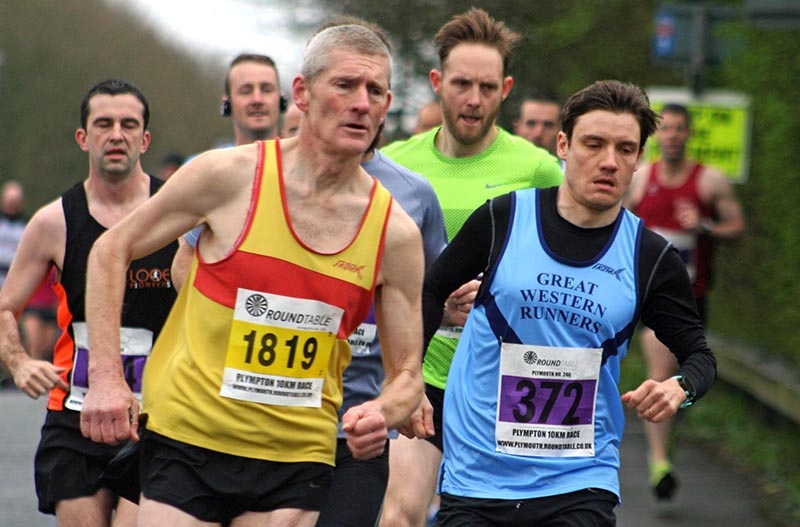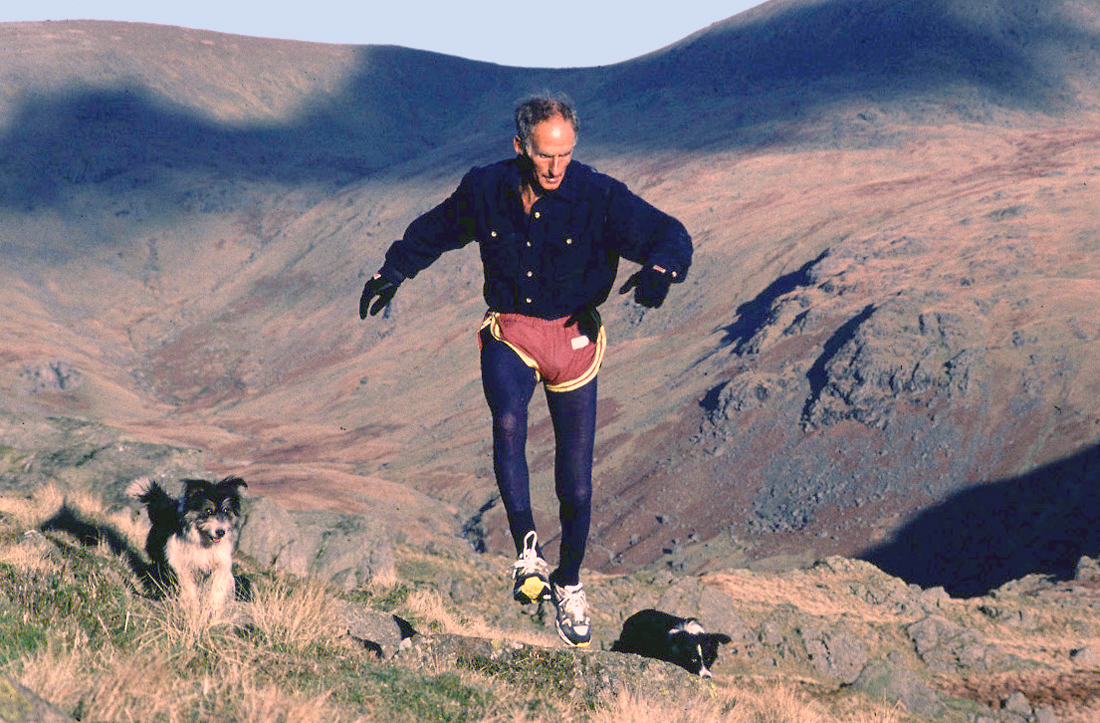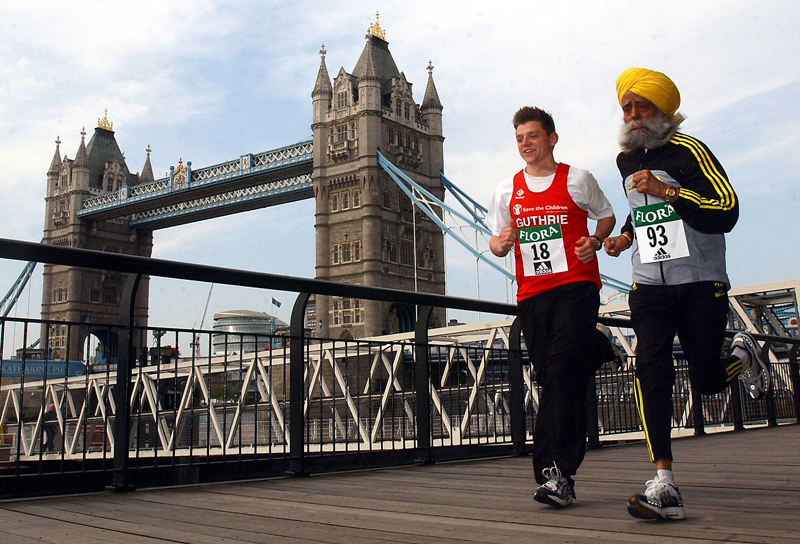A University of Florida study completed a number of years ago supported those traditional ideas about ageing. The Florida research, which followed regional and national champion track athletes over a 20 year period as they matured from 50 to 70 years of age, showed that maximal aerobic capacity(V02max) dipped by 10 per cent between the ages of 50 and 60 and then plummeted down by 12-15 per cent in the seventh decade of life. For a runner, such downturns would be equivalent to losing 30 seconds per year from a 10-K PB.Fortunately, no one bothered to tell Yekaterina Podkopayeva what would happen when she got older.
If you don't know about Yekaterina Podkopayeva, you haven't been following the world of running very closely. Podkopayeva is the only over-40 female who has ever run a 1500-metre race in less than four minutes. Podkopayeva's PB for the 1500 is 3:56.65, set about 10 years ago, so her decline in 1500-metre performance is just three-tenths of a second per year, confounding scientists who would have predicted a steady two- to three-second per year drop-off.P
And it's not just Podkopayeva, either
Is Podkopayeva a fluke - an isolated exception to the laws of nature? Not at all. Veteran (or masters) athletes have been doing science-defying things for a long time; it's just that we're finally beginning to notice their stellar performances. Jack Foster ran a 2 19 marathon at the age of 41, Priscilla Welch ran 2:26:51 over the same distance at the age of 42, and John Campbell scooted 26.2 miles in 2 04 at when he was 41. And let's not forget that Carlos Lopes set a world marathon record at the ripe old age of 38, a time when many scientists would have predicted that he would be reaching for a pipe and slippers.Running is by no means the only sport in which older athletes have been excelling. Before his recent retirement, baseball's 45-year-old Nolan Ryan whipped fastballs toward the plate at over 95 miles per hour, and I don't need to remind you that George Foreman recently won the world heavyweight title at the same age. The average age of professional athletes has been advancing steadily over the last decade.
These amazing performances have astounded experts familiar with the ageing process. After all, one commonly observed effect of ageing is a loss of muscle mass and a steady upswing in body fat. Since muscle provides propulsion while fat acts as a performance-hindering 'weight belt' under the skin, performances almost always fall off as muscles shrink and fat expands. To give an example of the effect of fat, consider a 154-pound runner with a V02max of 60 and a marathon PB of 2:43 who maintains his normal training and muscle mass but gains 4.4 pounds of fat. This extra cargo could tack about five full minutes on to his marathon time and send V02max spiralling downward by about 3 per cent.
Other potential effects of ageing include a decline in cardiac strength, a stiffening of the heart's walls which prevents the heart from filling fully between beats, and the narrowing of blood vessels due to an increase in fatty deposits. Studies suggest that the maximum amount of blood which can be pumped per heartbeat slackens by about 3-4 per cent per decade. Combined, these effects limit the heart's ability to send blood to the muscles, making high-intensity exercise more difficult.
Early studies on athletes confirmed that ageing was a very bad thing. For example, a famous investigation in 1967 re-examined Olympic athletes and world champions 27 years after they had retired from competitive sports. The findings were rather sad: V02max had declined by about 15 per cent per decade, a downturn which was actually greater than the one observed in sedentary individuals. A marathoner experiencing such a loss in fitness would experience a marathon slowdown of about 32 minutes in only eight years.
Dill puts doomsters in a pickle
However, there was also some evidence that ageing didn't have to destroy athletic potential at a rapid rate. Probably the most astonishing study analyzed the exercise performance of the legendary exercise physiologist D. B. Dill, who was tested each year between the ages of 37 and 93. Although that period was the exact time frame during which exercise capacity was supposed to plummet precipitously, Dill's V02max fell at a rate of less than ONE-THIRD OF ONE PER CENT PER YEAR, an astoundingly low figure. Dill was noted for his extremely high level of physical activity, which included multi-hour walks in the Nevada desert as he grew older. Although the hardy physiologist seemed to provide living proof of the axiom, 'Use it or lose it,' many exercise scientists regarded the tough-minded Dill as a physiological anomaly, unrepresentative of athletes at large.However, in 1987 researchers at the Mt. Sinai Medical Center in Milwaukee, Wisconsin reported something very strange: well-trained competitive runners with an average initial age of 52 years were able to completely maintain their V02max values over a 10-year period, during which aerobic capacity would have been expected to fall by about 10 per cent or more.
Unfortunately, subsequent analysis suggested that some of the athletes had INCREASED their training over the 10-year study, implying that their 'V02max maintenance' may have resulted from their not being in top shape at the beginning of the study. However, a follow-up study by Marc Rogers at Washington University in St. Louis indicated that age-related losses in fitness could be quite small. In fact, one of Rogers' athletes - a 55-year-old runner with an initial V02max of 57 ml/kg/min - preserved his aerobic capacity perfectly over an eight-year period and actually improved his 10-K PB from 38 minutes to 36:30!
Gradually, a number of exercise scientists have begun to realize that sometimes older is better, and innovative new research is showing that much of the decline in performance which accompanies ageing is actually the result of disuse - not the ageing process itself. In fact, the latest investigations suggest that athletes who continue training vigorously often don't experience significant drop-offs in performance until they reach their middle 40s or early 50s - or later. In addition, the eventual downturns are usually far smaller than expected.
Intensive training keeps age at bay
That great news has emerged from several scientific studies, including one completed recently at Ball State University in the United States. In this study, 37 elite runners (including Frank Shorter and former world record-holder Derek Clayton) were first tested in 1970 and then returned to the Ball State laboratory for re-evaluation in 1992. Eleven of the runners trained strenuously during the intervening years, 18 exercised fairly casually (running regularly but at an easy pace), and eight took up sedentary lifestyles. Most of the runners were in their mid- to late-forties when they were re-tested.The eight vegetative individuals exhibited characteristic declines in fitness, including a l5-per cent per-decade loss of aerobic capacity, a 12-beat per minute regression of maximal heart rate, a waning of running efficiency, and a significant shortening of stride length. The 18 runners who trained halfheartedly lost about 9 per cent of aerobic capacity per decade, just under the expected 10-15 per cent. However, the 11 individuals who continued training at a high level had no significant loss of V02max, maximal heart rate, running economy, or stride length, even though they had matured from 26-year-old spring chickens into 48-year-old graybeards.
Matthew Vukovich, Ph.D., one of the Ball State investigators, believes that high training intensity was the key factor which kept this select group of 11 athletes young. 'The runners who lost none of their aerobic capacity continued to carry out high-intensity interval training into their 40s; in fact eight of these individuals were high-school cross-country coaches who often ran interval sessions with their teams,' says Vukovich. Among the 11 perpetually youthful athletes was an Ohio resident named Ken Sparks, who was still running 4:13 miles at the age of 45.
Striking Sparks off the treadmill
At the age of 49, Sparks is still flying high, with plans to break the 4:20 barrier for the mile when he turns 50. Defying conventional wisdom, Sparks has shown a tendency to improve some of his race times as moved through his 40s; he ran a 2:40 marathon at the age of 41 and a nifty 2:28 six years later, for example. In addition, his mile PB of 4:03 at the age of 25 declined to a still-sweet 4:13 when he turned 45, a drop-off of only one-half second per year (that's an incredibly low downturn of 2 per cent per decade, even smaller than Podkopayeva's razor-thin losses). Sparks's V02max, gauged at 68 ml/kg/min when he was 19, now routinely rests in the 65-70 range. That's perfect preservation of aerobic capacity!Sparks's frequent, intense, interval training is an important contributor to his ageless running. Twice a week, Ken conducts interval sessions on a treadmill, zipping through quarter-miles at his best onemile race speed, with no more than one-minute recoveries. He also runs half-mile intervals in about 2:16-2:18 each, which is a tempo of about six to eight seconds slower per half-mile than his best onemile race pace. For the half-mile intervals, recoveries are again limited to one minute (keeping recoveries short during an interval session is an excellent way to keep oxygen consumption high during the overall workout and thus boost V02max). With about two to three miles of work intervals per training session (12 quarter-miles or six half-miles, for example), such workouts not only stimulate fast-twitch muscle fibres but also arrest V02max slippage.
'They're not easy,' says Sparks of his sizzling treadmill sessions. 'When I began doing these interval workouts when I was 40, I was so sore afterward that I initially thought I just wouldn't be able to continue the interval training for long. However, after several weeks the soreness began to disappear, and I started feeling much stronger. Sometimes my motivation flags a little bit, but I find that if I cut out the intervals for a couple of weeks and just run at a more moderate pace, I can eventually get my mind back into intense training again,' notes Sparks. He also gives himself plenty of recovery time. 'If I interval train on Monday, I'll usually run at a more moderate pace on Tuesday and Wednesday and not attempt intervals again until Thursday or Friday.'
Why the treadmill? 'Rain and wind can't bother you, and I find that treadmill running is a little easier on my legs.' Sparks, who is an excellent exercise physiologist in his own right, also believes that the high-speed treadmill efforts preserve the function of his fast-twitch, leg-muscle cells. 'Sometime after the age of 40, the nerves which control your fast-twitch cells begin to deteriorate, so you can begin to lose your footspeed,' says Sparks. 'Intense interval sessions seem to thwart this loss of velocity.'
In fact, statistical analysis revealed that the problems encountered by the University of Florida masters runners (described earlier ), who lost 10-15 per cent of V02max per decade were due to a failure to continue training at a high-quality pace. As soon as intensity levels fall off, it becomes very difficult to maintain aerobic capacity and running economy.
Even scientists can improve with age!
Like Ken Sparks, renowned exercise scientist Dave Costill, Ph.D., of the Human Performance Laboratory at Ball State University is another athlete who has actually performed better after he reached silver-haired status. As a college student, Costill's PB in the 1500-metre swim was 23:31, but at the age of 50 he covered the same distance in only 19:42, a close-to four-minute improvement!Costill also managed to upgrade his running performances as he moved through his 40s. At the age of 32, the hard-working investigator's PB in the 10K was 43:16, but at age 46 Costill rocketed through the same distance in a brisk 40:18. How did Costill do it? Unlike most ageing athletes, who gradually cut back on their training as they get older, Costill actually increased his workout load. In college, for instance, he swam about 7.5 miles per week, far below the 15-mile per week level he reached as a 50-year-old. As a runner, Costill ambled 25-28 miles per week at the age of 32 but accelerated to 41 miles per week at age 46. Sometimes it's nice to be a bit lazy when you're younger. If at a later date you expand your training to match your burgeoning age, your performances and chronological age can increase simultaneously.
In the Lapp of the gods
The 'new' discoveries about perpetually young runners are lessons which the Lapps - an energetic people who roam the northern reaches of Scandinavia while tending herds of reindeer - could have taught us centuries ago. The Lapps have a rather unusual cultural tradition: upon reaching the age of 55, a Lapp father gives the family's herd of beasts to his eldest son and retires to a life of sedentary reflection and story-telling around the campfire, a transition which transforms even the most wiry, fatigue-proof Lapps into lethargic doughnuts.When noted Swedish exercise physiologist Bengt Saltin transported treadmills to the tundra as part of a Lapp-testing project several years ago, he found that the herders' aerobic capacities remained at incredibly high levels up to the age of 55 but then plummeted as soon as permanent seats were taken at the fireside. As Saltin concluded, it's really a lack of exercise - not ageing - which makes fitness deteriorate appreciably as we get older.
Is the process the same for women?
Since the Ball State studies were carried out only with male athletes, they don't provide clues about possible age-related performance losses in females. At first glance, it might seem that declines in fitness would be independent of gender, but a key point to remember is that males produce their key sex hormone - testosterone - more or less continuously throughout life, while females' production of theirs, oestrogen, dips dramatically after menopause.Oestrogen may have a number of positive effects on performance, including a boosting of cardiac output and a preservation of bone density. Therefore, female athletes who don't opt for postmenopausal oestrogen-replacement therapy might suffer from weaker cardiac action, appreciable declines in bone density, a higher incidence of stress fractures, and greater overall rates of injury, all of which could downgrade performance and aerobic capacity by making consistent training more difficult.
In a new study conducted at the University of Colorado, Dr. Edie Stevenson is collecting valuable information about what happens to masters female athletes. Stevenson's group of 14 runners (aged 4967) includes several national- or world-record holders, as well as women who win age-group competitions at major races such as the annual Bolder-Boulder competition in Boulder, Colorado. The study hasn't been going on long enough to chart individual changes over time, but a comparison of the sixty-year-old runners with the fifty-year-olds suggests that the loss in V02max is around 10 per cent per decade, higher than the downturn observed in intensely training males in the Daniels or Ball-State research. However, one of Stevenson's runners lost only 4 per cent of V02max between the ages of 43 and 53, a very low rate of aerobic-capacity impairment.
'We really don't know if the process is the same for females and males,' says Stevenson. 'For women, we do tend to see a big drop in performance and V02max in the late 50s and early 60s, but we don't really know why this is happening. To figure out oestrogen's possible role, it would be interesting to give post-menopausal female runners who aren't on oestrogen-replacement therapy some supplemental oestrogen and look at how that influences their performances over time.' Most of the women in Stevenson's study are currently not taking oestrogen.
How Higdon stays young
Although the story for female athletes is still cloudy, the trend in males is clear: if intensity of training is maintained, age-related losses in fitness are slight. The running career of the American author and runner Hal Higdon is a case in point; Higdon experienced almost no decline in his running ability between the ages of 24 and 52.When he was 24, Higdon completed a 10K in 30:06 and a marathon in 2:21:55. At the age of 52, the Indiana runner breezed through a 10K in 31:08 and a marathon in 2:29:27. Those small downturns in performance represent a decline of only 2 per cent per decade, well below the 'normal' 10-15 per cent drop-off observed in many studies. In addition, Higdon's maximal heart rate diminished only slightly, his running economy (the amount of oxygen required to run at a given pace) did not worsen, and his V02max did not fall off at all between 1971 and 1981 as Higdon aged from 40 to 50!
Higdon's secret? Unlike most runners, he refused to let his training load decrease as he aged. In addition, Higdon coached a high school cross country team and carried out many of his team's intense workouts right along with the team. Like Ken Sparks, Higdon used high-intensity training to keep his legs young. Higdon's timeless running brings to mind the classic research carried out by University of Illinois scientist Dr. R. C. Hickson, who showed that aerobic capacity could be maintained for prolonged periods of time, as long as individuals continued to carry out a moderate amount of intense training. Yet speed training is often one of the first things that athletes give up as they get older.
The successes of Higdon and Sparks and the Ball-State research tell us that it shouldn't be a shock to remember that an 'over-the-hill' Carlos Lopes ran a 27:17 10K at the age of 37 and a 2:07:12 world record marathon at 38. Nor should it be a surprise to read about 43-year-old Larry Almberg running a 4:06 mile or 41-year-old John Campbell pushing through a 2:11 marathon. Since not much capacity is lost when serious exercisers reach their forties, the real surprise is that such performances weren't attained long ago! One of the main obstacles to superior senior performances has simply been that older athletes cut back on their training because they believed that they were too decrepit to achieve such 'miracles.'
Strategies to adopt
'If you stay highly motivated and injury-free and continue training at a decent intensity during your forties and fifties, you just don't lose very much,' says Ball-State researcher Vukovich. True, remaining injury-free isn't always an easy task, but new research indicates that more experienced athletes do have a lower risk of injury, compared to athletic newcomers. Current research also suggests that high mileage and lack of recovery days - but not high training intensity - are the paramount causes of injury.Since intensity is a more powerful producer of fitness than mileage, that's good news for older athletes! Masters runners can satisfy their bodies' desires for injury prevention and augmented recovery by cutting back on miles while slightly hiking average training intensity. It's easy to do. For example, a senior runner currently running six days a week for a total of 30 miles, with three of those miles 'fast' (at about IO-K race pace or faster), can simultaneously reduce the risk of injury and raise fitness by cutting back to a five-day, 25-mile weekly schedule, with FOUR miles at I O-K tempo or faster. The extra recovery day and lower mileage decrease the risk of injury, while the additional upscale mile improves V02max, running economy, and competitive performances.
The idea of adding in more recovery seems to fit well with older athletes' training needs. Famed masters runner Priscilla Welch noted that as she grew older, her speed didn't decline but she did sometimes require an extra recovery day after tough work J outs. The American marathoner Bill Rodgers noticed the same thing. Adding an extra recovery day doesn't mean that one's total training load has declined, because the additional recovery can facilitate higher-quality training on other days.
The other answer for older athletes, of course, is to maintain or even advance training volume by engaging in cross training (aquarunning, cycling, ski machining, and weight training if you're a runner, for example). Such workouts seem to produce less muscle-tissue damage, compared to running, and recent research suggests that they represent an excellent way to preserve V02max. Strength training is particularly important for athletes over the age of 50 - when atrophy of muscle and skeletal tissue begins to become a problem.
Fortunately, the bottom line for all of us is that advancing age doesn't have to spell an end to high-quality performances. With some basic adjustments in our training schedules, we can thwart time's attempts to slow us down and continue to perform at a high level.
Final note: ALWAYS consult your doctor before embarking on a programme of strenuous exercise.
Owen Anderson










